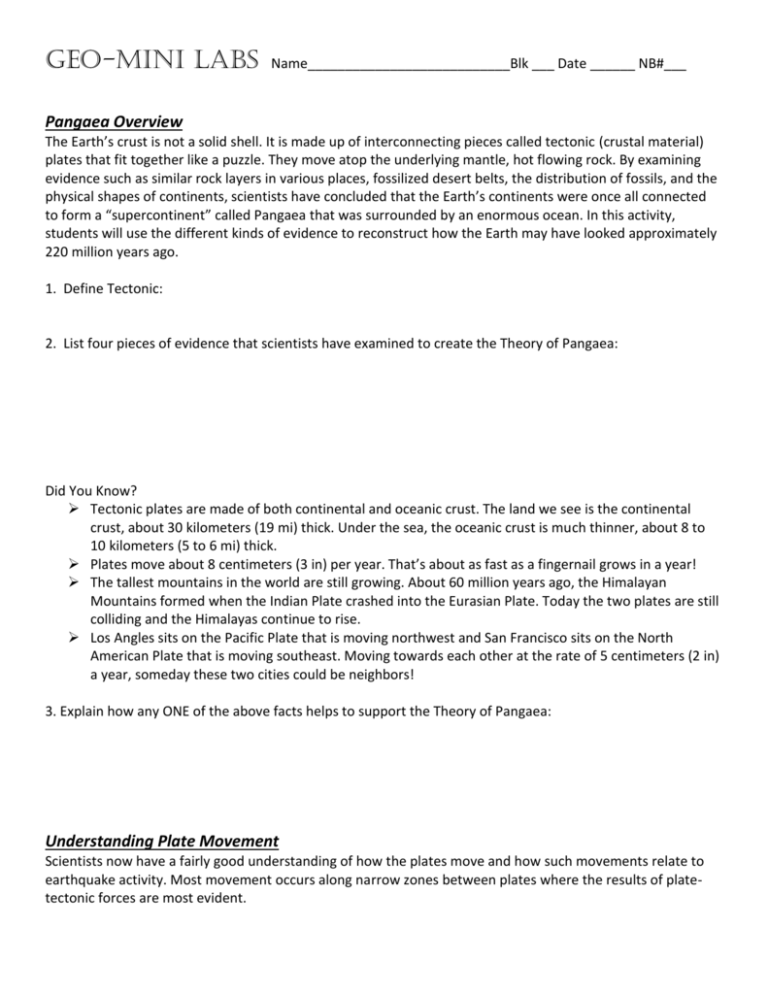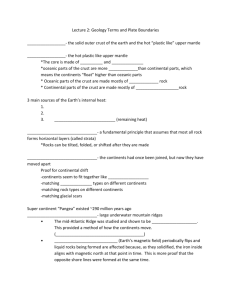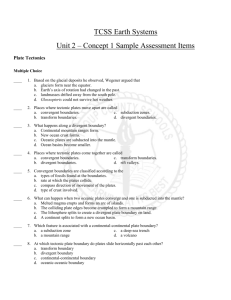Geo-Mini Labs Name___________________________Blk
advertisement

Geo-Mini Labs Name___________________________Blk ___ Date ______ NB#___ Pangaea Overview The Earth’s crust is not a solid shell. It is made up of interconnecting pieces called tectonic (crustal material) plates that fit together like a puzzle. They move atop the underlying mantle, hot flowing rock. By examining evidence such as similar rock layers in various places, fossilized desert belts, the distribution of fossils, and the physical shapes of continents, scientists have concluded that the Earth’s continents were once all connected to form a “supercontinent” called Pangaea that was surrounded by an enormous ocean. In this activity, students will use the different kinds of evidence to reconstruct how the Earth may have looked approximately 220 million years ago. 1. Define Tectonic: 2. List four pieces of evidence that scientists have examined to create the Theory of Pangaea: Did You Know? Tectonic plates are made of both continental and oceanic crust. The land we see is the continental crust, about 30 kilometers (19 mi) thick. Under the sea, the oceanic crust is much thinner, about 8 to 10 kilometers (5 to 6 mi) thick. Plates move about 8 centimeters (3 in) per year. That’s about as fast as a fingernail grows in a year! The tallest mountains in the world are still growing. About 60 million years ago, the Himalayan Mountains formed when the Indian Plate crashed into the Eurasian Plate. Today the two plates are still colliding and the Himalayas continue to rise. Los Angles sits on the Pacific Plate that is moving northwest and San Francisco sits on the North American Plate that is moving southeast. Moving towards each other at the rate of 5 centimeters (2 in) a year, someday these two cities could be neighbors! 3. Explain how any ONE of the above facts helps to support the Theory of Pangaea: Understanding Plate Movement Scientists now have a fairly good understanding of how the plates move and how such movements relate to earthquake activity. Most movement occurs along narrow zones between plates where the results of platetectonic forces are most evident. Geo-Mini Labs Name___________________________Blk ___ Date ______ NB#___ Types of plate boundaries Divergent boundaries – (also called Tension or Normal Faults) where new crust is generated as the plates pull away from each other. Divergent boundaries occur along spreading centers where plates are moving apart and new crust is created by magma pushing up from the mantle. Picture two giant conveyor belts, facing each other but slowly moving in opposite directions as they transport newly formed oceanic crust away from the ridge crest. Perhaps the best known of the divergent boundaries is the Mid-Atlantic Ridge. This submerged mountain range, which extends from the Arctic Ocean to beyond the south- ern tip of Africa, is but one segment of the global mid-ocean ridge system encircling the Earth. The rate of spreading along the MidAtlantic Ridge averages about 2.5 centimeters per year (cm/ yr), or 25 km in a million years. This rate may seem slow by human standards, but because this process has been going on for millions of years, it has resulted in plate movement of thousands of kilometers. Seafloor spreading over the past 100 to 200 million years has caused the Atlantic Ocean to grow from a tiny inlet of water between the continents of Europe, Africa, and the Americas into the vast ocean that exists today. 4. Explain what Divergent boundaries do: Convergent boundaries – (also called Compression or Reverse Faults) where crust is destroyed as one plate pushes toward another. The size of the Earth has not changed significantly during the past 600 million years, and very likely not since shortly after its formation 4.6 billion years ago. The Earth's unchanging size implies the crust must be destroyed at about the same rate as it is being created, as Harry Hess surmised. Such destruction (recycling) of crust takes place along convergent boundaries where plates are moving toward each other, and sometimes one plate sinks (is subducted) under another. The location where sinking of a plate occurs is called a subduction zone. The type of convergence -- called by some a very slow "collision" -- that takes place between plates depends on the kind of lithosphere involved. Convergence can occur between an oceanic and a largely continental plate, or between two largely oceanic plates, or between two largely continental plates. 5. Explain what Convergent boundaries do: Transform boundaries – (also called Shear of Strike Slip Faults) where crust is neither produced nor destroyed as the plates slide horizontally past each other. The zone between two plates sliding horizontally past one another is called a transform-fault boundary, or simply a transform boundary. The concept of transform faults originated with Canadian geophysicist J. Tuzo Wilson, who proposed these large faults or fracture zones connect two spreading centers (divergent plate boundaries) or, less commonly, trenches (convergent plate boundaries). Most transform faults are found on the ocean floor. They commonly offset the active spreading ridges, producing zig-zag plate margins, and are generally defined by shallow earthquakes. However, a few occur on land, for example the San Andreas Fault zone in California. This transform fault connects the East Pacific Rise, a divergent boundary to the south, with the South Gorda -- Juan de Fuca -- Explorer Ridge, another divergent boundary to the north. 6. Explain what Transform boundaries do: Geo-Mini Labs Name___________________________Blk ___ Date ______ NB#___ Pangaea Layout On the next clean pair of pages of your composition, label one page Today and the other page Pangaea. Cut out BOTH SETS of the continents. Separate into two piles. Layout the continental pieces on the Today page as the continents can be seen on Earth today. On the page labelled Pangaea, use the physical shape of continents to fit the continent puzzle pieces into one landmass. Remember not all the boundaries will touch, some continents may overlap some & there might be areas of water separating some of them. Once you are sure the landmasses are in the correct position, tape them down in your notebook. 7. What theory states the continents were at one time all connected? 8. What was that single land mass called? 9. Look at the shapes of continents and islands. What land- masses seem to fit together? 10. The prefix “pan” means all and the suffix “gaea” (geo) means earth. Therefore, what would Pangaea mean? Convection Current Watch the sawdust in the beaker and the wax in the lava lamp. Illustrate what appears to be happening in the beaker here in the drawing of the beaker. 11. Describe what a convection current is and how it is powered in the Earth. 12. The movement of the continental plates is powered by: Geo-Mini Labs Name___________________________Blk ___ Date ______ NB#___ Faults- Tectonic Movements 13. Using your piece of candy apply pressure as directed by the teacher and record your results, along with your other two table partners on the table below: Term Definition Schematic Drawing of Milky Way Two Plates Two Plates Two Plates 14. Discuss how the above stresses have impacted the world recently: __________________________________________________________________________________________ 15. Identify which tectonic movement is used to create the below landmasses: Mountains Valleys Trenches Ridges 16. What is the internal movement of the magma called and what role does it play in the faulting process:









